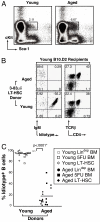Acquired hematopoietic stem cell defects determine B-cell repertoire changes associated with aging
- PMID: 18697924
- PMCID: PMC2515225
- DOI: 10.1073/pnas.0805498105
Acquired hematopoietic stem cell defects determine B-cell repertoire changes associated with aging
Abstract
Aging is associated with an inability to mount protective antibody responses to vaccines and infectious agents. This decline is associated with acquisition of defects in multiple cellular compartments, including B cells. While peripheral B-cell numbers do not decline with aging, the composition of the compartment appears to change, with loss of naïve follicular B cells, accumulation of antigen-experienced cells, and alteration of the antibody repertoire. The underlying cause of this change is unknown. We tested the hypothesis that aging-associated repertoire changes can be attributed directly to decreased B lymphopoiesis. Using an Ig transgenic model to report changes in the B-cell repertoire, we show that the reduced B-cell generative capacity of "aged" long-term reconstituting hematopoietic stem cells (LT-HSCs) alters the representation of antigen specificities in the peripheral B-cell repertoire. Further, we show that reconstitution using suboptimal numbers of fully functional LT-HSCs results in the generation of a similarly altered B-cell repertoire. This may be an important factor to consider when deciding the number of bone marrow cells to transplant in the clinical setting. In conclusion, when B lymphopoiesis is limited peripheral B-cell homeostasis is altered. This is reflected in reduced diversity of the B-cell repertoire, which likely reduces the protective quality of the immune response.
Conflict of interest statement
The authors declare no conflict of interest.
Figures




Similar articles
-
Chronic B cell deficiency from birth prevents age-related alterations in the B lineage.J Immunol. 2011 Sep 1;187(5):2140-7. doi: 10.4049/jimmunol.1100999. Epub 2011 Aug 1. J Immunol. 2011. PMID: 21810615
-
Withdrawal of sex steroids reverses age- and chemotherapy-related defects in bone marrow lymphopoiesis.J Immunol. 2009 May 15;182(10):6247-60. doi: 10.4049/jimmunol.0802446. J Immunol. 2009. PMID: 19414778
-
Senescent B lymphopoiesis is balanced in suppressive homeostasis: decrease in interleukin-7 and transforming growth factor-beta levels in stromal cells of senescence-accelerated mice.Exp Biol Med (Maywood). 2004 Jun;229(6):494-502. doi: 10.1177/153537020422900607. Exp Biol Med (Maywood). 2004. PMID: 15169968
-
Linking age-related defects in B lymphopoiesis to the aging of hematopoietic stem cells.Semin Immunol. 2005 Oct;17(5):321-9. doi: 10.1016/j.smim.2005.05.003. Semin Immunol. 2005. PMID: 15979895 Review.
-
HSC Aging and Senescent Immune Remodeling.Trends Immunol. 2015 Dec;36(12):815-824. doi: 10.1016/j.it.2015.10.008. Epub 2015 Nov 21. Trends Immunol. 2015. PMID: 26611154 Free PMC article. Review.
Cited by
-
Large-Scale and Comprehensive Immune Profiling and Functional Analysis of Normal Human Aging.PLoS One. 2015 Jul 21;10(7):e0133627. doi: 10.1371/journal.pone.0133627. eCollection 2015. PLoS One. 2015. PMID: 26197454 Free PMC article.
-
Immunological Endotyping of Chronic Critical Illness After Severe Sepsis.Front Med (Lausanne). 2021 Feb 15;7:616694. doi: 10.3389/fmed.2020.616694. eCollection 2020. Front Med (Lausanne). 2021. PMID: 33659259 Free PMC article. Review.
-
Hindlimb unloading, a physiological model of microgravity, modifies the murine bone marrow IgM repertoire in a similar manner as aging but less strongly.Immun Ageing. 2023 Nov 20;20(1):64. doi: 10.1186/s12979-023-00393-1. Immun Ageing. 2023. PMID: 37986079 Free PMC article.
-
Heme oxygenase-1 deficiency triggers exhaustion of hematopoietic stem cells.EMBO Rep. 2020 Feb 5;21(2):e47895. doi: 10.15252/embr.201947895. Epub 2019 Dec 29. EMBO Rep. 2020. PMID: 31885181 Free PMC article.
-
Zinc deficiency as possible link between immunosenescence and age-related diseases.Immun Ageing. 2025 May 19;22(1):19. doi: 10.1186/s12979-025-00511-1. Immun Ageing. 2025. PMID: 40390089 Free PMC article. Review.
References
-
- LeMaoult J, Szabo P, Weksler M E. Effect of age on humoral immunity, selection of the B-cell repertoire and B-cell development. Immunol Rev. 1997;160:115–126. - PubMed
-
- Bell DR, Van Zant G. Stem cells, aging, and cancer: Inevitabilities and outcomes. Oncogene. 2004;23:7290–7296. - PubMed
-
- Nicoletti C, Borghesi-Nicoletti C, Yang XH, Schulze DH, Cerny J. Repertoire diversity of antibody response to bacterial antigens in aged mice. II. Phosphorylcholine-antibody in young and aged mice differ in both VH/VL gene repertoire and in specificity. J Immunol. 1991;147:2750–2755. - PubMed
-
- Linton PJ, Dorshkind K. Age-related changes in lymphocyte development and function. Nat Immunol. 2004;5:133–139. - PubMed
-
- Weksler ME. Changes in the B-cell repertoire with age. Vaccine. 2000;18:1624–1628. - PubMed
Publication types
MeSH terms
Grants and funding
LinkOut - more resources
Full Text Sources
Medical

